Note:
The Decathlon Riverside Touring 920 was provided to me for a test at my request. Therefore, this is advertising.At the beginning there was the book…
Actually, it is a small booklet, called Adventure Book. With it, Riverside welcomes every rider and makes you want to go on an adventure. In the booklet you learn who is behind the bikes, gets a brief outline of the development history and then has a great tour book for the first adventures on the bike.

Sometimes it’s the little things that inspire and I asked myself why other manufacturers don’t do the same? So you connect the “tool” bike directly with the experience bike trip and makes you want to set off and immediately want to ride.
Decathlon Riverside bikes – a brief excursion
I first became aware of Riverside on Instagram a year and a half ago and have since followed the development process of their new travel, Bikepacking and Gravel bikes. Riverside Bike Trekking is a bike brand from Decathlon. And before now one or the other skeptically raises his or her eyebrows: The team behind it consists of proven bike enthusiasts and experts, who had almost free rein in the development of the new touring bikes. According to Riverside, the Touring 520, 900 and 920 bikes were extensively tested on more than 500,000 test kilometers. This distance was also and especially completed by many bike travelers and Bikepackers who rode the prototypes around the world. And with some of the developers and test riders I have interviewed for this article, also to learn more about the background and operations in practice.
I found it particularly interesting that you could follow this development on Instagram and in some cases also participate in the decision for details. Overall, a really smart, transparent and diverse approach to developing a bike from my point of view. And like the Adventure Book, it’s an idea that other manufacturers could also take a look at.
And the Riverside team can be really proud of the result. I’ve heard a lot of good things about the bikes and especially about the Decathlon Riverside Touring 920, which was the reason for my test request to Riverside. And this much I can already reveal: My expectations and the advance laurels the bicycle was justified.
From the idea to the bike: Interview with César Bygodt from Riverside
César is responsible for communications at Riverside Bike Trekking and I asked him a few questions about Riverside Decathlon and the development of the Touring 920:
Riverside & You: who are you, what do you do at Riverside and who/what is Riverside?
My name is Cesar, I’m a 25-year-old French bike traveler and I have a dream job at Decathlon: I’m in charge of communication for Riverside, Decathlon’s bike trekking brand. Within this team, there is a small group of passionate people who develop a complete offer for bike travelers and Bikepackers.
What were the reasons for developing the Riverside Touring 920?
The Riverside Touring 920 is the wildest bike in our range. Our goal is to make bike touring and Bikepacking accessible to many. That’s why we’ve developed two other road-oriented bikes: the RT520 – perfect for EuroVelo travel, and the RT920 – the world travel bike. But we also want to make Bikepacking more accessible. We want more people to explore our planet on trails with Bikepacking kits on their bikes. So we’ve designed a bike that’s affordable, but at the same time very capable of making the biggest adventure dreams come true. The bike has already finished the Atlas Mountain Race or the Baroudeuse (in France). It’s just as suitable for the short off-road overnight as it is for the Great Divide Mountain Bike Route or the circumnavigation of the globe.
How did you develop and test the bike? I saw that you guys involved the community?
The design process was pretty unique. First, because of its length of four years. And second, because it wasn’t just us as a core team designing a bike at our HQ. We knew that if we wanted to design good touring bikes, they had to be tested all over the world. So we did over a hundred 1:1 interviews with bike travelers. Once we had prototypes, we sent them out on the road with our “ambassadors.” Our prototypes cycled over 500,000 kilometers in those four years. We also used Instagram to co-design, and the community had an influence on many different aspects, not just color: components, materials, designs, etc…

What are you most proud of with the RT920?
We are proud to bring to market an ultimate Bikepacking bike that is affordable and will expand access to our sport and community. But we’re also super proud of the fact that we didn’t compromise. Quality always came before cost and delays. It took us a long time to develop the bike, but in the end, quality was all that mattered. That’s pretty unique. Lastly, we are proud to have done this with the community. We’re a small, passionate team, but there were hundreds of us who brought it to life. Designed by travelers for travelers is not just a slogan, we mean it.
How do you guys actually achieve these fairly low price points?
Decathlon is a big company and a big bike builder: we design a wide range of different bikes, but we buy our components together. Also, our distribution system is unique: no middlemen, we develop and sell our products directly ourselves.
Demand is very high: when can interested parties in Europe/Germany expect deliveries?
The second shipment is planned for April in Europe. Unfortunately, only a few quantities will be available, because the situation in the bicycle industry is very complicated at the moment. The demand is very high, but the production capacities cannot follow this demand. However, we will have more bikes in autumn 2021.
Addition by Decathlon Germany: “The first batch of 200 units in November/December was sold out within two days. We are currently planning 500 units for 2021 for Europe, of course depending on the availability of components. The quantities are split between April and October.”

What’s next, what are you working on?
We’re working on bags mostly right now: Bike travel bags (for the handlebars, front and rear) and a complete Bikepacking kit. They will be available in the summer of 2021. We are also working on a cargo cage and a special drybag. We always have great projects we are working on.
The bike: Decathlon Riverside Touring 920 in detail

The Touring 920 is positioned as a “bike for the wildest adventures”. And I can certainly agree with that. I have ridden the RT920 over 350km and was also with him on Overnighter tour to test his handling in loaded condition.
Interestingly, the Touring 920 is an absolutely robust Jeep for off-road and at the same time a sporty gravel bike for fast tours and travel.
A frame-set for all occasions
The frame of the Touring 920 is of course the eye-catcher and looks very solid – in a positive sense. The frame-set is made of aluminum with a carbon fork. It is said that aluminum frames are very hard and stiff. I could not determine so, which was probably also due to the carbon fork and the wide tires, which have enough suspension.
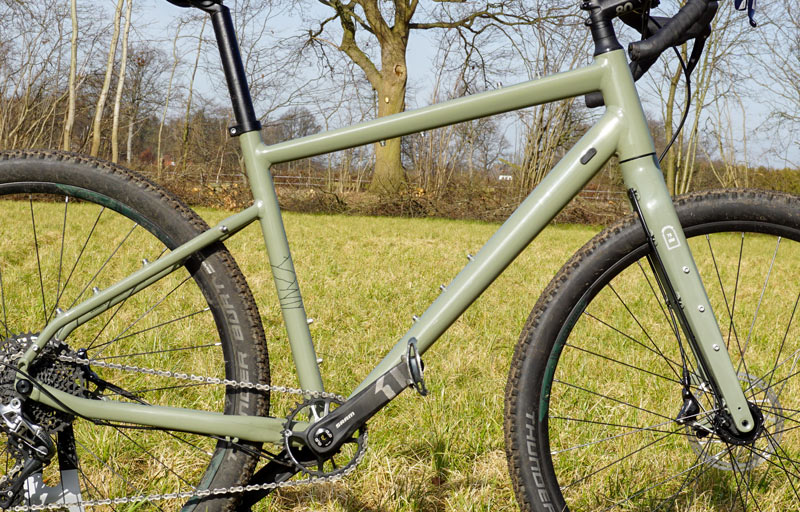
But as for the stiffness: the bike rides like on rails. Whether with or without luggage – it is sometimes very surprising how well it keeps track, even on rougher terrain. In my view, this makes it particularly suitable for Bikepacking and bike touring beginners.
The riding position is quite comfortable and reminiscent of my Salsa Fargo. When comparing the frames, however, it turns out that the RT920 has quite a more aggressive geometry and allows for a rather sporty riding position. In practice, however, this is not perceived to me as particularly different from the Fargo. The stack is already clearly different at 671mm Fargo to 623mm RT920. But also the Reach is quite different with 385mm at the Fargo to 414mm at the RT920.
An interesting feature I find the height of the bottom bracket on the RT920, or ground clearance. This is with 314.2mm (measured at 29″/2.25″) almost 2cm higher than that of the Fargo with 298.2mm.
The RT920 is more like the geometry of the Bombtrack Beyond (2020) and has a similar stack (637mm Beyond vs 623mm RT920) and slightly less reach (395mm Beyond vs 414mm RT920). However, the ground clearance here is even more different than on the Fargo: at 291.8mm, the Beyond is about 22mm lower than the RT920.
I had the frame size L with a 80mm stem. With my height of 184cm it was quite comfortable, not stretched and the handlebars were easily accessible and operable in all positions.
What is particularly noticeable about the frame-set of the RT920 are the numerous eyelets. And indeed, very good thought was given here to which mounting points a Bikepacker or bike traveler might need. A total of 33 eyelets and screw-on points are provided on the bike.

On the top tube are two eyelets each at the top and bottom. A cockpit bag can be screwed to the top, while below either a holder for the fuel bottle or air pump can be attached.
In the frame triangle, the three eyelets stand out: so you can change the position of the bottle holder again and adapt to a frame bag. Of course, eyelets for bottle holders are also attached to the down tube.
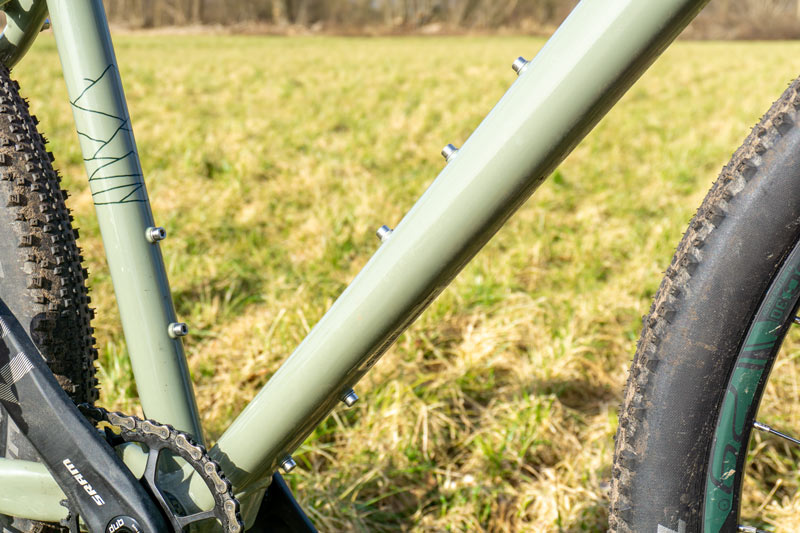
The massive eyelets on the saddle stays are particularly prominent. According to César, three on each side are intended for mounting Riverside’s own rack and for attaching bottle holders or anything cages.
I tried this out, of course. The bolts on the saddle stays are thicker than the other eyelets. Normally M5 screws are used, here in the back it is M6. This means bottle cages you get already screwed, but it may be that the screw hole is not large enough at the holder.

After the bottle cage was mounted, I found that a large 950ml/1L bottle does not fit. It is too long and comes into contact with the tire, or there is simply no space for it. Even a 0.75l bottle has problems, but would be possible. Only with a 0.5l bottle it went well.
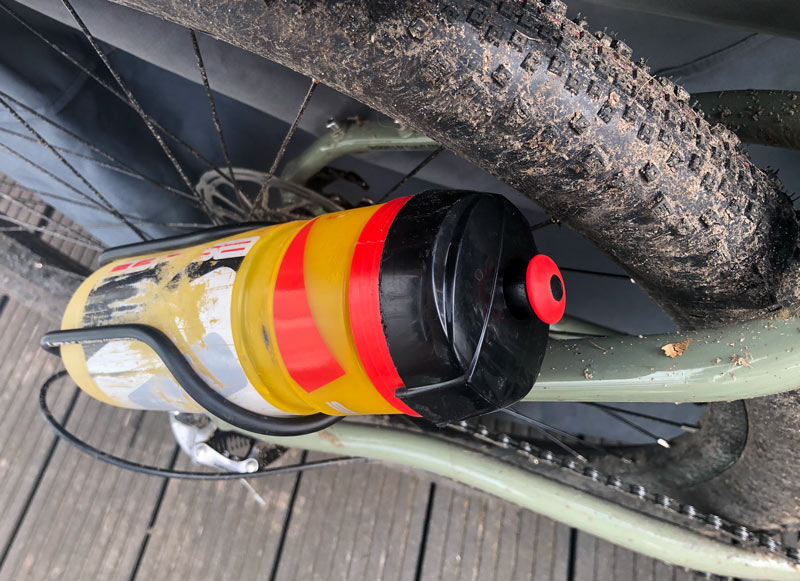
I ended up carrying my toolbox there. So consider that in your planning. Maybe you can move the eyelets by an adapter to the outside and then has enough space for a larger bottle. With cargo cages I’m skeptical whether they really fit there, because they are usually a little wider than bottle cages and thus come into contact with the tire. I had the idea to mount Anything Cages to transport there a 1 liter Nalgene bottle. That does not work. At least not in my case.

The carbon fork of the RT920 also offers a lot: 3 eyelets on each side make it possible for the cyclist to attach a lightweight front rack, LowRider or Anything Cages or Ortlieb Fork Bags. Unlike many other Bikepacking forks with eyelets, the Riverside the eyelets are mounted parallel to the wheel. So in the 90 degree angle and not in the 45 degree angle to the front or / and rear, as for example with a Salsa Firestarter fork. (Maybe it is also other degrees of angle, but you understand that already 🙂 )

The frame also looks so tidy because the cables for the gearshift and rear brake have been moved inside the frame. This is visually well solved and makes the attachment of frame bags easier.
What looks so massive must also weigh a lot. The answer is: no, or not really. The weight of the frame-set I unfortunately do not know, but the complete bicycle including pedals weighs 12.5 kg.The weight of the frame-set I unfortunately do not know, but the complete bicycle including pedals weighs 12.5 kg. This makes the RT920 as heavy as my Bombtrack Beyond. And I think that if you only use the screws that are actually used individually and remove the others, you can save quite a bit of weight.

In addition, the frame has a massive advantage over many other bikes in this category from my point of view: the permissible system weight (rider, luggage, bike weight) is 170kg. Thus, the RT920 is also and especially suitable for heavier riders or people who want to take a little more on tour.
And: Decathlon gives a lifetime warranty on frame, fork, stem and handlebars.
In addition to the 170kg system weight, the four sizes in which the R920 is offered are also very interesting for both smaller and larger riders:
- Size S from 1.55m to 1.65m
- Size M from 1.66m to 1.77m
- Size L from 1,78m to 1,89m
- Size XL from 1.90m to 2.01m

What I particularly like (and I would not have expected here) is the replaceable derailleur hanger. This should be standard anyway, but I was very pleased to see it here on the wheel. By the way, included in the delivery is also a roll bag, which contains a replacement derailleur hanger, spokes and pedals. This is very thoughtful and a true customer experience.
Another note to those who like to have a stand on their bike: the RT920 has the appropriate plate built in for a center stand at the bottom bracket. Probably more interesting for the travel cyclists among you who need to park the bike with stand.
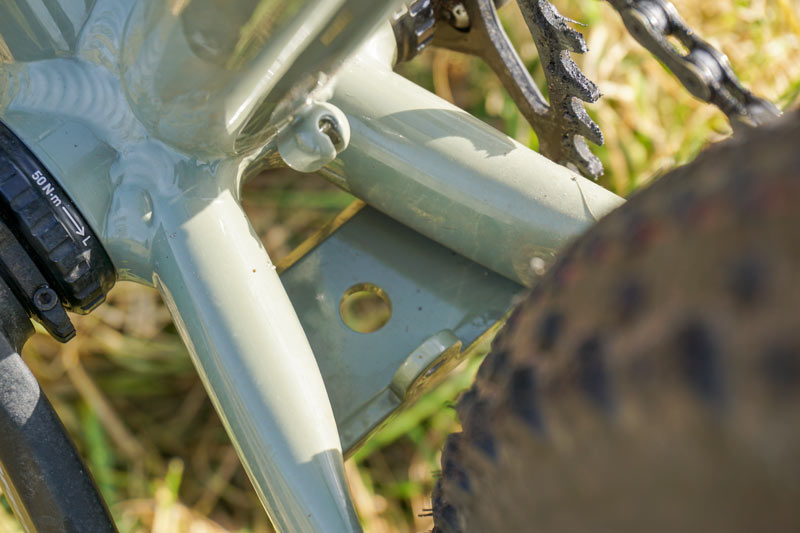
Simple and performing: drivetrain, gears & brakes
With a total price of 1,500 euros for the Decathlon Riverside Touring 920, I would have guessed mid-range gearing. Interestingly, the test bike comes with a 1×11 SRAM Rival, which I also ride on my Fargo. The Rival is comparable in categorization with the Shimano 105 and is, in my view, a very reliable and almost indestructible gear group – ideal for Bikepacking.
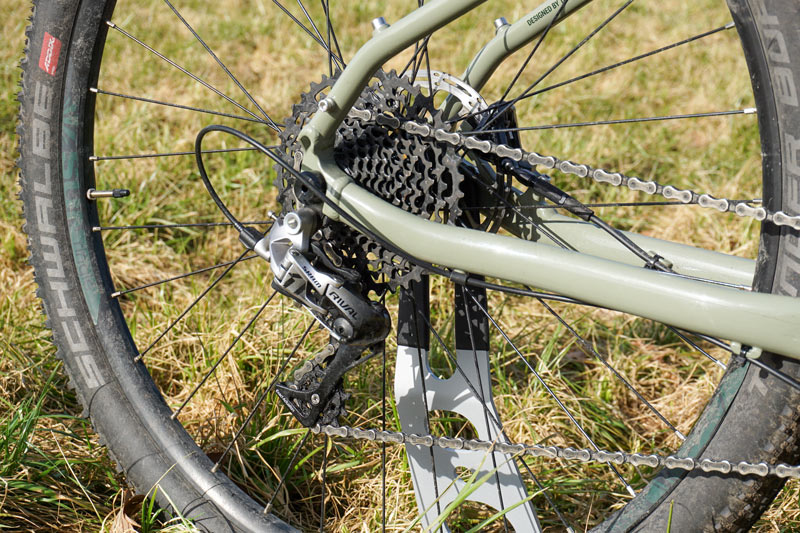
The bottom bracket is a SRAM DUB bearing (BSA screw bearing). This bearing standard of SRAM I also have on the Fargo. It set on crank axles with a diameter of 28.99mm (Shimano Hollowtech has 24mm) and should be more stable and lighter.
In this DUB bearing a crank with 32er chainring is used. According to Decathlon, chainrings with a size of 34, 36, 38 and also 40 can be installed in front.
Note: depending on the frame size, the installed crank lengths vary: 170 mm (S/M) and 175 mm (L/XL).

At the rear works a SRAM Rival with long cage, together with a 11-speed 11-42 cassette. In general, this is enough for touring with light luggage. For Bikepacking tours with many vertical meters, rough trail conditions and some luggage I would convert to a 11-46er cassette. The Rival rear derailleur works without tools also with a 46t cassette. Likewise on classic bike tours with luggage, you can possibly convert to a 34t or 36t sheet in front, if it needs a little more speed on the flat. In general, however, 32 on 11 is quite enough to get ahead faster.
To what extent on the Riverside Touring 920 can also be mounted a 2-speed shifting, would have to check.

The chain is also from SRAM: on the RT920, the PC1130 is used. I’m also often ridden this and had that on my tour through Kenya and Tanzania in use. It lasts with me about 5,000km.
Brakes are hydraulic and from Rival. The are very proven and bring the wheel even loaded with its 160mm brake discs safely to a halt. The pressure point is very well felt and if you like, then the wheels also block.
Bike on the Rocks: The Riverside Touring 920 at the Atlas Mountain Race
Pierre Gouyou Beauchamps, who rode the Atlas Mountain Race with this bike, was able to prove that the RT920 can really take a beating. I asked him a few questions about it:
The Atlas Mountain Race was a tough test ride: how does the Riverside perform as an endurance Bikepacking bike?
I really enjoyed riding the Riverside 920 during the Atlas Mountain Race. I tested it for the first time in the French Alps, mostly on roads because it was winter at the time. It felt light, strong and reliable. The wheels gave me a good feeling: they were light and stable.
During the AMR I carried 8-9 kilos of gear in 5 Bikepacking bags: on the top tube, frame, saddle and two on each side of the fork. That felt good, even though I kind of felt like I was the only one carrying that many bags… Anyway, the bike did very well off-road, even if it was bumpy as hell in some places.
Three things you like most about the Riverside and why?
Its lightness and ruggedness. I also like the way it looks, which is important. I think you have to love your bike when you take it on an adventure. One more thing: I’m 5’8″, and I took the XL version of the bike. Even though I’m tall, the bike felt really fitting and sufficiently large, and I enjoyed that. It felt like riding a big, strong machine. The position on the bike is also great: no back pain after 6 days and 10 hours on 1,150 kilometers of difficult terrain.
The 920 has eyelets everywhere so you can literally attach anything you want to the frame. There’s even a row of holes on the seatstay to carry water or small bags on either side of the rear wheel.
Ok, that’s more than 3 things 😉

Is there anything you do not like so much?
The SRAM Rival shifter was sometimes hard to handle, but I don’t know if that’s the case with all models. When I wanted to shift to a lower gear, the shifter would jam in the grip.
To what type of rider/for what type of touring would you recommend the Riverside?
I recommend it for riders who want to go on a long term adventure. Be it on asphalt or gravel. Change the tires to suit your own adventure and this bike will take you far.
I also recommend it to riders looking for a comfortable bike. The combination of 29-inch wheels and tubeless tires provides excellent grip and position.
Rolling: Wheels, Tires & USB Charger
For the wheels, Decathlon goes with Sun Ringlé Düroc 30 rims. I don’t know the rims, but it seems to be a very solid and also affordable choice. And with a rim width of 32mm, it’s also just right for slightly wider tires on the RT920. 32 spokes also provide sufficient stability in my view.
Let’s move on to another element on the RT920 that I like: often Bikepacking and travel bikes come without the quite useful option of a power supply. This then means that you have to retrofit a hub dynamo.

Decathlon has made the right thoughts here before and equipped the RT920 with a hub dynamo from Shimano XT. But that’s not all: with the Cycle2Charge there is also the appropriate USB charger. This I have installed on the Bombtrack – but have charged there only once. It has no buffer battery, but is a completely sufficient start in the topic of power supply on the road. If you want to learn more about the charger, I recommend the test article from the GPS-Cyclist Matthias.

But the hub dynamo also offers at the same time the possibility to mount a corresponding light. To do this, however, you have to be interrupted the already done and quite clean wiring of the loader to install a light with.
Back to the wheel: in front rolls the Shimano XT hub dynamo and rear was installed an OEM hub from Leeche. I could not find anything about this and we have to see how this hub performs on the wheels over time. However, the field reports from the AMR (above) and from Patagonia (below) shows that it is obviously a very reliable and durable solution.

Furthermore, the 100 × 12mm front and 142 x 12mm rear thru axles with quick release on the RT920 provide more stability. Thru axles should be standard on all Bikepacking and Touring bikes anyway.

Decathlon also relies on proven tires: the 29″ Schwalbe Thunder Burt with 2.25″ width (57-622) roll very well on asphalt and in the forest. However, if it is wet and muddy, they suck tight, which costs power. In return, however, they offer really good traction.
By the way, 2.25-inch wide tires are not the end of the possibilities: According to the colleagues from Bikepacking.com, even up to 2.4-inch wide tires fit in the frame/fork of the Riverside Touring 920.

Unfortunately – but this is complaining on a high level – the RT920 is delivered with a tube. And with my luck I had then of course also immediately a flat tire. I can therefore only recommend everyone to then convert the wheels to tubeless.
Good for the long haul: handlebar & saddle
In the beginning we were not friends: when I first mounted the Riverside Touring Adventure handlebar, I was not so much taken. Somehow I couldn’t get a comfortable grip. But as is often the case, the fault sat before the device, because once properly adjusted the handlebar was a small revelation. He is pleasantly wide with 620mm (for the wheel sizes M, L and XL) and with a flare of 24 degrees for me very suitably flared. The Reach of 52.6mm and the drop of 115.5mm ensured that I could ride very well in the lower as well as upper handlebar and always had control over shifting and braking.

I particularly liked the handlebar ends. These are bent on a length of about 4 cm again upwards. This leads to the fact that you can control the bike very well even in the lower handlebar with your hands at the end. Overall, this handlebar is ideal for long distances and offers not only many grip combinations, but is also wide enough for large handlebar bags.

I was similarly surprised as by the handlebars from the saddle: here too, Decathlon used no NoName parts, but the Brooks Cambium C15 Carved.
Carved means with a slit / slot in the middle. This makes the C15 very comfortable. I was impressed how well the actually quite narrow saddle with 140mm made with me.

Unlike the genuine leather models, the Brooks Cambium saddles are made of natural rubber, covered with nylon. This makes them weather-independent and the otherwise necessary run-in of the saddle is not necessary.
I liked it so much that I am even considering the C15 or C17 as a new saddle to me. In any case, the RT920 thus has a saddle that fits immediately and with which you can ride many thousands of kilometers without problems. Depending on the size of the rider you can perhaps switch to the slightly wider C17 – but that depends on the seat bone distance, which you can also easily determine at home.
With the Riverside Touring 920 through Patagonia (and further)
I spoke with Katrin of CyclistsHeandingUp, who is on a grand tour with her boyfriend Matthieu, riding the Panamericana from South to North. A classic bike trip with the RT920.
Patagonia is a great testing ground: How does the Riverside perform as a touring bike and on long trips?
We have already ridden 5,700 km in South America and before that about 1,300 km along the Danube. We had all kinds of road surfaces, from asphalt to rocky terrain to volcanic sand. I had no problems at all and the bike is equipped with high quality components. The only mechanical effort I had sometimes fine-tune the shifting/cassette again, clean the brake pads/discs and oil the hydraulic brake levers. But that can all be easily done yourself with a little basic mechanical understanding.
In addition, the Riverside Touring 920 is quite light (11 kg) compared to other touring bikes. Especially in South America, where it goes up and down quite a bit, this is an advantage. Also on difficult terrain, if you have to push or lift the wheel times.
Only B-low for long distances: Where to put the luggage? I was until now really light on the road and Matthieu had much more weight for it. But we are working on an optimization (probably also with the Bikepacking luggage kit from Decathlon, but is not yet fixed). We have yet also met some travelers who are in Bikepacking mode, so it is definitely possible to make even very long trips so. But it is clear that you can not take all his little comfort 😉

Three things you particularly like about the Riverside and why?
Ergonomics: The seating position is sportier than on classic touring bikes. For me at least, this is much more comfortable and energy saving than pedaling in an upright position. The handlebars should also be mentioned here. It allows different position for the hands, both in width and height.
Weight: Sure, there are some who think that a few kilos more or less now also make no difference. But if it goes times 20 km uphill, one is nevertheless glad about each kilo less!
The many mounting holes allow a very individual equipment, tailored to the needs of the driver. In front, for example, cargo cages can be fixed. In the back additional water bottles. In the frame there are many different options, depending on whether you want to use a frame bag or fix other accessories.
Is there anything that you do not like so much?
As already mentioned above, the only problem for us on very long trips is the limitation in luggage volume. But if you stick to the essentials and are a bit inventive, that can be solved as well.
To what type of rider/for what type of trip would you recommend the Riverside 920?
Definitely for sporty/challenging tours, i.e. for a lot of elevation gain and routes off the main paved roads. But the biggest advantage of this bike is actually its polyvalence, as it can be used for any situation/route.
Summary: The all-rounder for sporty bikepacking & comfortable bike trips
If you think of Decathlon as bikes that are inexpensive but not really suitable for hard or long use, the Riverside Touring 920 will prove you wrong. Here the French have developed a bike that shows a deep understanding of the needs of bikepackers and bike travelers.

“Designed by travelers for travelers” is therefore not just a marketing slogan, but a provable attitude and enthusiasm of the team behind the Riverside Touring bikes.
The geometry is a successful blend of sportiness and comfort. As a Bikepacking bike it impressively quietly and stably pulls its course and gives the rider always the feeling of complete control – even when loaded.
When it comes to mounting options on the frame, the Riverside Touring 920 is second to none. However, that also makes it quite heavy. Although I see the 12.5 kg weight (weighed myself) as not particularly heavy for this category of bike. For comparison: my Bombtrack Beyond also weighs 12.5kg, my Norwid Gotland travel bike 17kg.
Speaking of weight, the system weight of 170kg is really an advantage, as it makes it suitable for heavier riders as well as fans of the heavy-duty faction. And the sizes for riders from 1.55m up to 2:01m are also worth noting.
Of course, the price is also an absolute advantage: for 1,500 euros you get a very well equipped bike that is ready to go on tour. Unfortunately, the availability this year is anything but optimal. For 2021, another 500 units are to be produced in Portugal for Europe in April and October together, which in view of demand and the good supply is unlikely to be enough by a long shot.

You may already notice: I really liked the Riverside Touring 920. I felt very comfortable on the bike. It pulls like a jeep its course on forest paths, trails and gravel roads. And on the road, it’s smooth-running and fun – loaded or unloaded.
That makes it ideal, in my view, for those who can’t or don’t want to commit to Bikepacking or bike touring. In addition, the RT920 can also be a gravel bike.
And more importantly, it looks good too.
In short: a jack-of-all-trades that offers a lot of bike for comparatively little money, and in any case guarantees limitless fun on the bike.
More reviews of the Riverside Touring 920
If you want another view of the bike, here’s the video from Bikepacking.com:
The Decathlon Riverside Touring 920 at a glance
- Frame: Aluminum 6061
- Fork: Carbon, 12×100 mm thru axle
- Drivetrain: SRAM Rival 1×11
- Crank: SRAM DUB with 32t
- Sprocket: SRAM 11-42t
- Wheels: Sun Ringle Düroc 30, 32c, Tubeless
- Front hub: Shimano XT hub dynamo with 12x100mm thru axle
- Rear hub: Leeche with 12x142mm thru axle
- Tires: 2.25″ Schwalbe Thunder Burt (57-622)
- Brakes: SRAM Rival hydraulic
- Brake discs: 160mm
- Handlebar: Riverside Touring Adventure, width: 680mm (from size M), Reach: 52.6 mm/Flare: 24°/Sweep: 4°/Drop: 115.5 mm
- Stem: aluminum, lengths: S: 60 mm/Size M: 70 mm/Size L: 80 mm/Size XL: 100 mm
- Saddle: Brooks Cambium C15 Carved
- Seatpost: aluminum, diameter: 31.6 mm, lengths: S/M/L: 350mm; XL: 400mm
- Price: 1.499 €









God damn shame this bike isn’t available any more in Decathlon stores. Do you maybe know is it sold out or discontinued. not even product pages are available any more.
Hi Baho,
no idea. I assume there is another contingent coming for Europe end of this year.
Martin